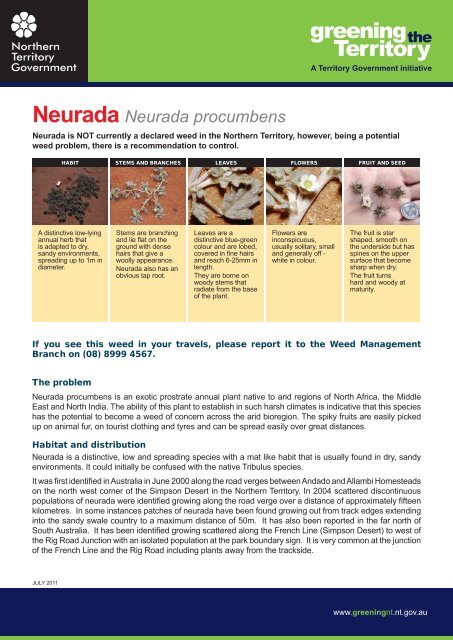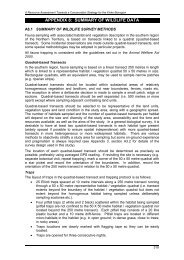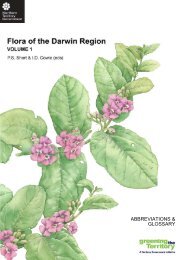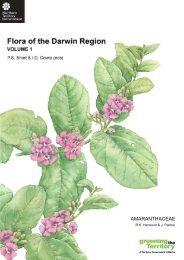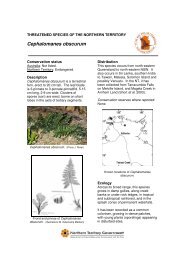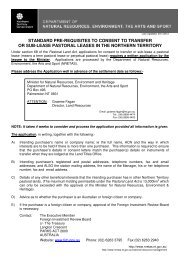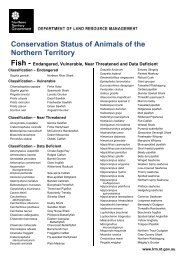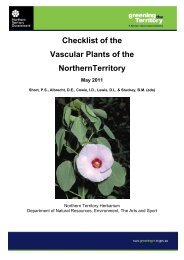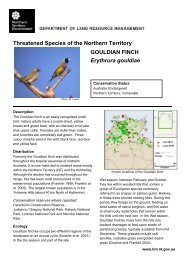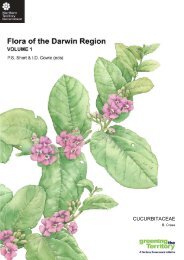Neurada Neurada procumbens
Neurada Neurada procumbens
Neurada Neurada procumbens
You also want an ePaper? Increase the reach of your titles
YUMPU automatically turns print PDFs into web optimized ePapers that Google loves.
<strong>Neurada</strong> <strong>Neurada</strong> <strong>procumbens</strong><br />
<strong>Neurada</strong> is NOT currently a declared weed in the Northern Territory, however, being a potential<br />
weed problem, there is a recommendation to control.<br />
If you see this weed in your travels, please report it to the Weed Management<br />
Branch on (08) 8999 4567.<br />
The problem<br />
<strong>Neurada</strong> <strong>procumbens</strong> is an exotic prostrate annual plant native to arid regions of North Africa, the Middle<br />
East and North India. The ability of this plant to establish in such harsh climates is indicative that this species<br />
has the potential to become a weed of concern across the arid bioregion. The spiky fruits are easily picked<br />
up on animal fur, on tourist clothing and tyres and can be spread easily over great distances.<br />
Habitat and distribution<br />
<strong>Neurada</strong> is a distinctive, low and spreading species with a mat like habit that is usually found in dry, sandy<br />
environments. It could initially be confused with the native Tribulus species.<br />
It was first identified in Australia in June 2000 along the road verges between Andado and Allambi Homesteads<br />
on the north west corner of the Simpson Desert in the Northern Territory. In 2004 scattered discontinuous<br />
populations of neurada were identified growing along the road verge over a distance of approximately fifteen<br />
kilometres. In some instances patches of neurada have been found growing out from track edges extending<br />
into the sandy swale country to a maximum distance of 50m. It has also been reported in the far north of<br />
South Australia. It has been identified growing scattered along the French Line (Simpson Desert) to west of<br />
the Rig Road Junction with an isolated population at the park boundary sign. It is very common at the junction<br />
of the French Line and the Rig Road including plants away from the trackside.<br />
JULY 2011<br />
HABIT STEMS AND BRANCHES LEAVES FLOWERS FRUIT AND SEED<br />
A distinctive low-lying<br />
annual herb that<br />
is adapted to dry,<br />
sandy environments,<br />
spreading up to 1m in<br />
diameter.<br />
Stems are branching<br />
and lie flat on the<br />
ground with dense<br />
hairs that give a<br />
woolly appearance.<br />
<strong>Neurada</strong> also has an<br />
obvious tap root.<br />
Leaves are a<br />
distinctive blue-green<br />
colour and are lobed,<br />
covered in fine hairs<br />
and reach 6-25mm in<br />
length.<br />
They are borne on<br />
woody stems that<br />
radiate from the base<br />
of the plant.<br />
Flowers are<br />
inconspicuous,<br />
usually solitary, small<br />
and generally off -<br />
white in colour.<br />
The fruit is star<br />
shaped, smooth on<br />
the underside but has<br />
spines on the upper<br />
surface that become<br />
sharp when dry.<br />
The fruit turns<br />
hard and woody at<br />
maturity.<br />
www.greeningnt.nt.gov.au
Despite efforts to restrict spread from its original known location, it has now been found in other areas<br />
throughout Central Australia.<br />
In the Northern Territory neurada is starting to spread at a number of campgrounds in the region. Camels,<br />
cattle and rabbits occur in the vicinity of the primary infestation and their tracks have been observed amongst<br />
plants. These animals are likely to disperse the fruit some distance from existing population and camels<br />
particularly are likely to be the main vectors for the spread of the species into areas distant from vehicle<br />
tracks.<br />
Preventing spread of neurada<br />
Spread prevention is always the most successful and cost effective way of managing weeds. <strong>Neurada</strong><br />
seeds are readily spread by domestic stock, water flow (rain, floods), feral animals and by human means.<br />
As neurada has been found in a number of areas frequented by tourists, it has become evident that all<br />
visitors should be aware of how to identify neurada and avoid inadvertent spread. Anyone travelling though<br />
areas affected by neurada should check vehicles, clothes, shoes and camping gear to ensure they are<br />
not carrying neurada’s spiky fruit. These infestations are current management priorities as further spread<br />
and establishment into clean areas is a significant risk. Given the extremely limited extent of neurada<br />
infestations, it is very important that any new plants are immediately controlled following detection. Even<br />
plants which have been controlled should be reported so that necessary follow up can occur.<br />
<strong>Neurada</strong> control<br />
Prevention and early intervention are the most cost-effective methods of control. The success and type of<br />
control measure used will depend on the situation, although foliar spraying with herbicide or hand pulling are<br />
generally the preferred forms of control for the low density infestations found in the Northern Territory.<br />
Seed germination generally occurs following significant rainfall events. This is therefore the best time to look<br />
out for and control neurada.<br />
Physical removal of <strong>Neurada</strong> is quite easy as the plant is small and easy to access due to its current low<br />
infestation levels. As the Northern Territory only has low density neuarada infestations, hand pulling is the<br />
most appropriate form of physical control.<br />
If tourists find the spiky seeds on their clothing or car tyres etc, the best way to destroy these seeds is to<br />
collect them and burn them in a campfire.<br />
Chemical control<br />
Chemical and<br />
concentration<br />
2, 4-D amine 625g/L<br />
Various trade names<br />
Glyphosate 360 g/L<br />
Various trade names and<br />
formulations<br />
Rate Situation, method and comments<br />
320 ml / 100L Seedling or adult (individuals or infestation)<br />
Foliar spray - apply when actively growing<br />
10 ml / 1L Seedling or adult (individuals or infestation)<br />
Foliar spray - apply when actively growing<br />
Optimum treatment time – 4-6 weeks after rainfall in the region<br />
Follow up<br />
It is vital that follow up works are carried out to control seedling recruitment and regrowth after a site has been<br />
treated. It is unknown how long <strong>Neurada</strong> seeds can remain viable in soil, so monitoring will need to continue<br />
for at least 10 years in areas where neurada is known to have seeded. As seeds germinate after significant<br />
rainfall events, this is the optimum to do follow up and monitoring activities.<br />
www.greeningnt.nt.gov.au
Disclaimer<br />
In the Northern Territory, a registered weed control product must only be used in situations consistent to<br />
those appearing on the label, unless authorised under a permit; and a person:<br />
● must not have in their possession or use a chemical product unless the product is registered in Australia<br />
(exemptions apply);<br />
● may use a registered product at a concentration, rate or frequency lower than that specified on the label<br />
unless this is specifically prohibited on the label. This does not apply to herbicide use occurring under<br />
an APVMA permit;<br />
● may use a registered product to control a pest not specified on the label provided the pest is in a situation<br />
that is on the label and use on that pest is not specifically prohibited on the label; and<br />
● may also use a registered product using a method not specified on the label unless this is specifically<br />
prohibited on the label.<br />
Users of agricultural (or veterinary) chemical products must always read the label and any permit, before<br />
using the product and strictly comply with the directions on the label and any conditions of any permit. Users<br />
are not absolved from compliance with the directions on the label or conditions of the permit by reason of any<br />
statement made in or omission from this publication.<br />
Further information<br />
For further information on weed management planning, integrated control, herbicide application techniques<br />
and monitoring please refer to the NT Weed Management Handbook. Information is also available on our<br />
website at www.nt.gov.au/weeds.<br />
The Weed Management Branch can be contacted on phone:89994567 or email: weedinfo.nretas@nt.gov.au<br />
www.greeningnt.nt.gov.au


